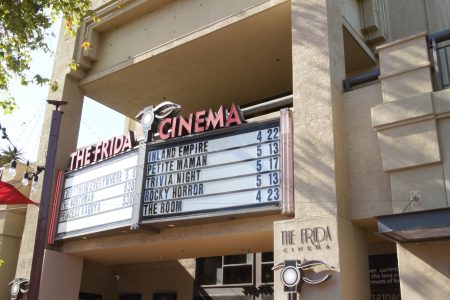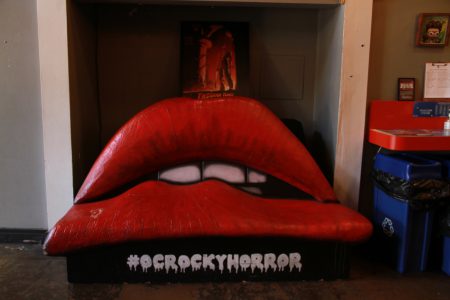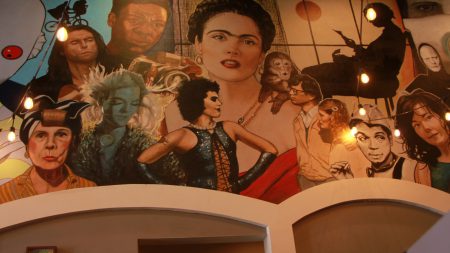After the 2020 pandemic, it took about a year for movie theaters to reopen. It took longer for theaters to offer a variety of films that were not superhero movies. Major blockbusters, such as “Spider-man: No Way Home” and Robert Pattinson’s “The Batman” became available to either purchase from home or watch for free in record breaking time. All Warner Brothers films, often starring A-list actors, such as “The Little Things” with Denzel Washington and Jared Leto were immediately available with an HBO Max subscription.
By April 2021 both AMC and Regal began to reopen their screens to Southern Californians but by then home viewing had dominated the movie industry. Since then films have stayed in mainstream theaters for a shorter amount of time than ever before, challenging the integrity of films.
In a climate where streaming services have trumped ticket sales and rentals, there is a unique style of movie watching that challenges both theaters and streaming. On a wavelength of their own, independent movie theaters, commonly referred to as “indie” theaters, are typically smaller theaters that screen art house, cult classics and non-mainstream films. Unlike mainstream movie theaters, indie theaters do not typically show large production films, attracting a more niche market rather than a mass audience. With mass approval out of the way, independent theaters are free to offer an enriching cultural experience along with the film on screen. Often hosting film festivals, offering live introductions by the creators of the film and engrossing the audience with an environment that demonstrates a respect for cinema, these theaters offer a sense of community.
Indie theaters often show films that allow creators such as directors, writers or producers to experiment and potentially produce an irreplicable piece of art, usually sacrificing a large distribution. Creators believe that this type of film will attract the audience, rather than an A-list actor or a large production budget. Whereas mainstream theaters were showing “Spider-Man: No Way Home” in December of 2021, independent theaters were likely showing Venice Film Festival’s Silver Lion award winner “The Hand of God,” which went on to be nominated for an Oscar the following year.

Logan Crow, founder and executive director of the non-profit independent art house theater The Frida Cinema, has the definition of art-house painted atop the theater’s box office for everyone to see: “A mission driven community-based theatre that exists for the love of cinema and the cultural enrichment of local communities.”
The Frida is the the only non-profit, independent art house cinema in Orange County and has been a part of Santa Ana since 2014. The largest and most heavily populated city in Orange County, Santa Ana visually reflects its history and culture throughout the city streets, making it the perfect location for The Frida Cinema.
“Downtown Santa Ana has a very energized community,” Crow says. “I think that art house…works well to compliment that kind of a scene.”
The art and culture is heavily represented in the architecture, murals, restaurants and small businesses. An epicenter of Orange County, along with Orange and Anaheim, Santa Ana offers a unique blend of racial and cultural backgrounds while forefronting the heavily Latino community.
The Frida, named after the famous Mexican surrealist painter Frida Kahlo, offers more than just films; the Frida is an ode to cinema. One opens its front doors to find they must have accidentally walked into a pop culture museum. It is small, but homey and the high ceilings are hugged by murals of of iconic film characters, such as Jack Nance’s character in David Lynch’s “Eraserhead” and Salma Hayek’s representation of Frida Kahlo. Once the shock passes, you notice the smell of popcorn from behind the counter hitting your nostrils and refreshments that revive the memory of entering a movie theater. The hanging lights keep a dim atmosphere, as opposed to the traditional alarming neon. Every corner of the building emotes playful movie culture, from the framed movie poster on the wall to a giant lips bench modeled after “The Rocky Horror Picture Show” in the lobby.

Being an art house theater, The Frida shows a handful of serious films that are more artistic than, say, a Fast and Furious movie. Curated by Crow and the Frida’s Programmer and Director of Special Events Trevor Dillon, The Frida sometimes shows films that have mainstream theater releases, such as the newly released “Everything Everywhere All at Once” starring Michelle Yeoh. Typically they focus on critically acclaimed and impressionable pieces such as the 1966’s “Tokyo Drifter,” a film about the Yakuza directed by Seijun Suzuki known for its bizarre visualization and creative camerawork.
Due to the unconventionality of some of the films shown in indie theaters they often don’t get worldwide recognition or praise. There are thousands of movies shown explicitly at film festivals and independent movie theaters that are shown to an audience a handful of times but never obtain a large release or are shown again.
Movie distributors send representatives to film festivals to see whether there is potential money in an independent film. They pick a handful of movies to fund from hundreds of films shown at hundreds of screenings. Independent movie theaters give you the opportunity to see the films that are literally a once in a lifetime opportunity.
“That was exciting to bring these films from Slovenia to Downtown Santa Ana,” Crow offers such films at The Frida. “To bring those films here means a lot to me. You can come see a film here that you may not otherwise get a chance to see anywhere else.”
The Frida also offers exclusive showings for classic movies. Each month they have film themes celebrating a different genre of film. April’s theme was Studio Ghibli, an animation production company that creates fantastical films, five of which are among the top 10 highest grossing Japanese anime feather films. They showed classics such as “Spirited Away” and “My Neighbor Totoro,” a film about young kids befriending whimsical spirits. The Frida has also partnered with a variety of organizations, such as “Breath of Fire Latina Theater Ensemble” and “Asian Industry B2B” in 2020, as well as welcomed schools of all grades to showcase and teach about film. This art house theater is a cinematic art hub that has been able to survive by the strength of the community.
Community is not always enough for some theaters. With mainstream theaters such as Regal and AMC still feeling the hit of the pandemic, it is no surprise that independent theaters faced similar struggles. Over the pandemic the Arclight Cinemas and Pacific Theaters closed permanently. With a combined 12 locations in Southern California alone, about 300 screens are no longer available to Southern Californians. This includes Hollywood’s beloved Cinerama Dome, easily recognized by the colorful blocked lettering and the iconic dome roof that glows a sultry blue at night. Previously home to a multitude of stage premiers, cinephiles were devastated when entertainment establishments began to reopen in 2021, but the Cinerama Dome in Hollywood never opened their doors to the public again.
Mainstream movie theaters have an advantage in that they have more publicity, locations and financial stability. Although they also offer film viewings, ultimately they are not direct competition. They have different objectives.
“Its a different animal…They’re too big to be competition,” Crow describes how he tackles the marketing for The Frida. “Our job is how do we tap into new communities…to let them know we are playing avant garde cinema and classic cinema. That they may find a home here for their interests.”
Attending a mainstream movie theater can offer more options for showings of mainstream movies recently released, but one can’t get the same experience of meeting the director or attending a Q&Q. Independent movie theaters, like The Frida, offer opportunities like checking out local talent, watching a niche film from a nation thousands of miles away or catching a friend at the same screening.

The Frida Cinema, like mainstream theaters, had to shut down during the pandemic. Feeling a responsibility to his community and his employers, it didn’t take long for Crow to spring into action.
“The mission has to keep going,” Crow told his employees. He had two and a half months worth of PPP loans to get a drive-in theater going. Dedicated to helping the community, The Frida hosted drive-in events all around Orange County, often adjacent to struggling businesses in order to lend a hand. Unlike theaters such as AMC and Regal, they were able to provide drive-in events for a year and a half while also offering rental opportunities on equipment and staff so other communities could host events as well, such as a Lenten mass for a small church and a handful of student film premiers.
There are still a handful of theaters in Orange County that offer distinct indie vibes alongside early screenings and art house experiences. Starlight Cinemas have a few locations, including Anaheim, Garden Grove and Costa Mesa. In central OC there are The Lot and The New Port Theater in Corona Del Mar, which have been home to a handful of film festivals such as the Newport Beach Film Festival.
Film festivals are a great way to experience indie theaters and films. Non-stop movie watching is enjoyed for days through a variety of genres and usually including films from different countries. Documentaries, foreign films, animation, B-movies, experimentation and more are all given the spotlight for a week or two and celebrated by not only creators but the community.
While we can’t always go to film festivals and watch movies for hours, you can still visit your local independent or art house theater to enjoy a non-mainstream film, be a part of the community, and help support a small business without breaking the budget. Instead of immediately turning to an AMC in search of some new entertainment, considering indie theaters are a way to stay in touch with the small man’s art oftentimes enjoying a more intimate experience. Although an avant garde experience will not be experienced the same by everyone, it is still nice to have the option for a different type of art in cinema.
“It either speaks to you or doesn’t,” Crow stresses. “But if you don’t have it, then you don’t have that element, that opportunity to have someone provide you a filter to make sense of some of the things in this world that make absolutely no sense.”
